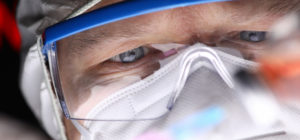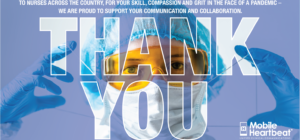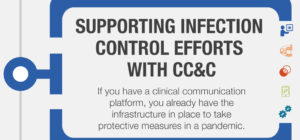We’ve spent the past few months outlining tips and strategies for making the most of your organization’s clinical communication and collaboration (CC&C) solution during critical events, all with the hope of easing the strain many health systems are under right now. Clinicians and hospital employees everywhere are having to adapt to dangerous, ever-evolving circumstances because of the coronavirus pandemic. As many facilities across the country are continuing to see COVID-19 cases rise, we want to make it as easy as possible for essential healthcare workers to access actionable and intuitive guidance.
1. Prepare Your Hospital
Responding to critical events always requires some degree of preparation, and a pandemic is no different. Everyone across the enterprise has a role to play in preparation, including the CC&C solution your organization uses. This article outlines some of the major ways you should be prepping, including the nuances of deploying the Incident Command Center.
You can also watch the webinar we created that goes even deeper on preparing your CC&C solution for critical communications.
2. Take Stock of Resources
In a healthcare environment, access to adequate resources is critical. When you’re in the midst of a pandemic, having updated and clear information about supply inventory and staff whereabouts is crucial to mobilizing care effectively. Check out this article for more information on using your supplies to your advantage during the pandemic.
3. Scale to Field Hospitals
If your healthcare organization has been accommodating a high number of cases and new admissions are not diminishing, you may need to deploy a field hospital. Unfortunately, this can bring its own set of challenges, including inter-facility communication and collaboration. Our Director of Program Management, Lauren Clancy, outlined several steps you can take to scale your communications to these field hospitals.
4. Preserve Supplies
With a highly infectious virus overtaking much of the world, dwindling personal protective equipment (PPE) has been a significant issue for healthcare delivery organizations. Fortunately, there are clever ways to use a nurse call system integration to preserve PPE for necessary circumstances only. In our latest one-pager we provide some information on how this can be done, and include several sample workflows as inspiration.
5. Minimize Infection Risk
As frontline employees, clinical staff are more at risk for contracting COVID-19 than any other profession. Even if your organization has enough PPE for all colleagues, the risk is still there. Infection control efforts are likely in overdrive right now, and they could use all the support they can get from your CC&C solution. We’ve outlined some of the best ways your organization can ramp up infection control strategies in this article. You can also download the infographic here.
6. Count On Your Technology
In healthcare, you can always count on the stakes to be high. They can be no higher when humanity is facing a deadly pandemic. That’s why your organization needs to be able to rely on the technology infrastructure you have. Your systems should be interoperable, flexible and dependable. Mike Detjen, our Chief Operating Officer explains exactly why this is so important in our article on achieving 100 percent uptime.
7. Support the Care Team
Even in the best of times, frontline healthcare staff are particularly prone to burnout. And in a time when they are battling the brunt of the pandemic, supporting them is more important than ever. In his latest article, our Chief Executive Officer, Ron Remy, highlighted some key ways your organization can make the right tools and resources available to your staff. This can include anything from mental health hotlines to meditation videos to helpful links.
It’s hard to say when, if ever, things will go back to normal after coronavirus. But with the right tools and strategies, your healthcare organization can streamline critical communications and make the workplace as safe as possible for the people who are saving lives every day.





